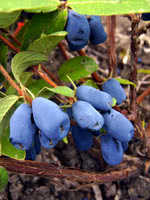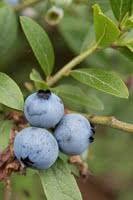Mon-Fri 9am - 5pm Mountain time
Tundra Haskap (Honeyberry) vs Lowbush Blueberry
Lonicera caerulea Tundra
Vaccinium angustifolium
Tundra Haskap is sweet/tangy with a great flavour. The flavour of Haskaps is generally described as a cross between a blueberry and a raspberry. Tundra Haskaps are well suited to fresh eating, freezing, baking, and preserves. They have the firmest berries, which makes them well-suited for commercial production
For optimal fruit production, cross-pollination is required. Haskaps need to be planted with a compatible variety. Compatibility is influenced by both bloom time and genetics.
Tundra Haskap is an early-pollinating variety and pairs well with Aurora and Honey Bee.
Lowbush Blueberry, commonly known as the Wild Lowbush Blueberry, is often wild-harvested and thrives in low pH acidic soil. This early low-bush blueberry produces white and pink bell-shaped flowers in the spring. Its fruit is smaller in size than high bush blueberry plants and is more flavourful with an intense blueberry taste-masking it perfect for fresh eating, baking, and preserves.
Note: Blueberries require very specific soil conditions. They need well-drained soil with a pH between 4.5 and 5.0. If the starting pH of your soil is between 5.1 and 6.2 you can lower it by adding sulfur. We recommend against planting blueberries in soil with a starting pH greater than 6.2. Please do your own research before buying any blueberry plants.

